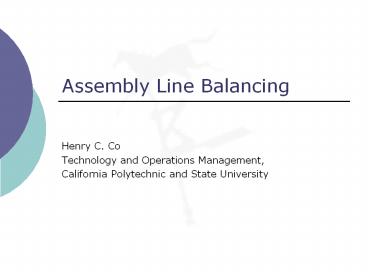Assembly Line Balancing - PowerPoint PPT Presentation
1 / 11
Title:
Assembly Line Balancing
Description:
Assembly Line Balancing (Henry C. Co) 3. Concepts (1/2) Minimum rational work element ... Total work content: Sum of the task times for all the assembly tasks ... – PowerPoint PPT presentation
Number of Views:2390
Avg rating:3.0/5.0
Title: Assembly Line Balancing
1
Assembly Line Balancing
- Henry C. Co
- Technology and Operations Management,
- California Polytechnic and State University
2
Scheduling High-Volume- Low-Variety Operations
- The mass consumption patterns of modern
industrialized nations depend on assembly line
technology. - The classic example is Henry Fords auto chassis
line. - Before the moving assembly line was introduced
in 1913, each chassis was assembled by one worker
and required 12.5 hours. - Once the new technology was installed, this time
was reduced to 93 minutes. - Favorable Conditions
- Volume adequate for reasonable equipment
utilization. - Reasonably stable product demand.
- Product standardization
- Part interchange-ability.
- Continuous supply of material
- Not all of the above must be met in every case.
3
Concepts (1/2)
- Minimum rational work element
- Smallest feasible division of work.
- Flow time time to complete all stations
- Cycle time
- Maximum time spent at any one workstation.
- Largest workstation time.
- How often a product is completed.
- Inverse of the desired hourly output rate the
amount of time available at each work station to
complete all assigned work.
4
Concepts (2/2)
- Total work content Sum of the task times for all
the assembly tasks for the product. - Precedence diagram network showing order of
tasks and restrictions on their performance - Measure of efficiency
5
The Problem
- Assign tasks to work stations observing balancing
restrictions so as to minimize balance delay
while keeping station work content for every
station cycle time. - Restrictions
- Technological precedence requirement.
- Position restrictions.
6
Finding a Solution
- Heuristic procedures generally allow for a
broader problem definition, but do not guarantee
optimal solution. - Optimizing procedures generally have used more
narrowly defined problems, but guarantee optimal
solution. - Examples of optimizing procedures
- Dynamic programming
- 0-1 Integer programming
- Branch and bound techniques.
- Trend in research has been toward optimizing
procedures due to availability of large-scale
computers.
7
A Simple Algorithm
- Identify tasks whose predecessors have been
assigned to a workstation (available tasks). - Determine from available tasks, those that fit,
i.e., those whose tasks times time remaining to
be filled at this work station. - Choose a task that fits by some decision rule
- task with largest time
- task with most successors
- task with greatest sum of task times of its
predecessors. - Continue steps 1 to 3 until no task fits, then go
on to next workstation. - Continue steps 1 to 4 until all tasks are
assigned.
8
Illustrative Example 1/3
- Youve just been assigned the job a setting up an
electric fan assembly line with the following
tasks
9
Illustrative Example 2/3
10
Illustrative Example 3/3
11
Complications
- Behavioral options
- Job enlargement and rotation.
- Wages related to task.
- Distribution of slack time.
- Inventory buffers.
- Involving work group in decisions.
- Arranging stations to facilitate interaction.
- Personnel selection.
- Time to move an item between stations
- Machine-dominated work stations.
- Task times which exceed the cycle time.
- Stochastic task times.
- Mixed model assembly lines.

